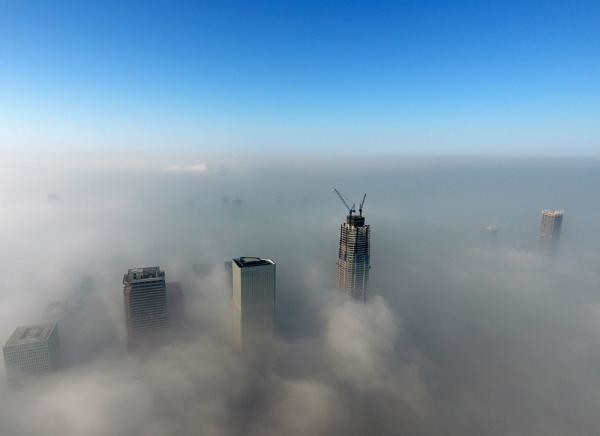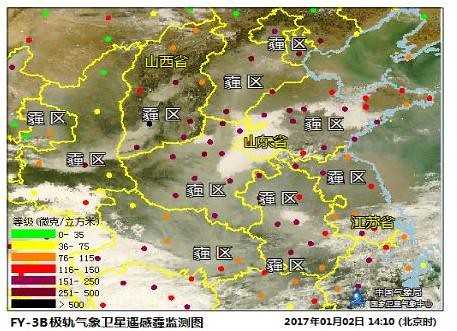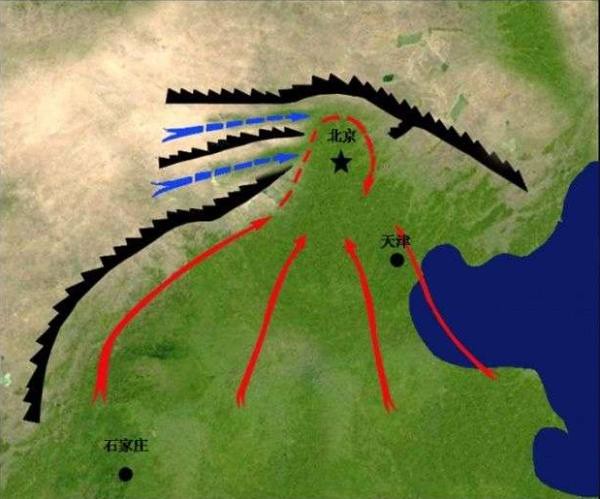
On January 4, the Tianjin yujiapu roof of buildings under construction through the haze, sunny over about 400 meters from the ground, ground, fog and haze. Dongfang IC
On January 7, 2017, the China Meteorological Administration, based in Beijing-Tianjin-Hebei region prone to smog, causes haze weather held media briefing, introduces the effects of meteorological causes of haze.
Participating meteorologists said low atmospheric environmental capacity and atmospheric self-purification ability, such as adverse weather conditions, was led to the recent haze in Beijing-Tianjin-Hebei area prone to repeat the main inducement; in the next few years, haze is still a main trend in winter.
According to the China Meteorological Administration, November 2016, the Beijing-Tianjin-Hebei region of China in a total of 7 times and heavy haze weather. December 16 – 21st and from December 30 to January 7, 2017 at the time, a wide range of long duration, the degree of pollution.

14:10 January 2, 2017 FY third satellite monitoring PM2.5 concentrations on the ground and the 14:00 monitor, showing haze in the Middle East area of more than 700,000 square kilometers in China. China Meteorological Administration image self-purification capacity low atmospheric environmental capacity and atmospheric weak
Associate researcher at the Chinese Academy of meteorological Sciences Liu hongli introduced determines the average pollution levels of air pollution emissions, smog event is driven by weather conditions.
Liu hongli said, 2016 in Beijing-Tianjin-Hebei area PM2.5 per hour and weather conditions in which the contribution of, and relationship to 71.3%. "That is the past year, 70% ups and downs of the pollution is mainly decided by the weather conditions."
National climate Centre shows that November 2016, the cold air in Beijing-Tianjin-Hebei area less, average wind speed, small number of days.
Specific performance, fewer cold air, the strength is weak in General. Since November, the East Asian winter monsoon weak, appears only 6 times a cold process, than the same period of normal years (8.2 times) less. Overall weak cold air, North-active path. In the case of the lack of cold air, static stability in Beijing-Tianjin-Hebei area weather, poor weather conditions of atmospheric diffusion. Meanwhile, average wind speed, small number of days. November 2016, the Beijing-Tianjin-Hebei wind than the same period of normal years (annual mean that 30 years of 1981-2010, the same below) average is small, small November over a year earlier to 8%, December 19% smaller; small wind is more than the annual average over the same period, November 7%, December 18%. Is more pronounced in Beijing November average wind speed decreased to 20%, decrease December 27% November small wind days in 27%, December 35%.
Chief Ai Wanxiu think the meteorological conditions of the national climate Center, led to the recent low atmospheric environmental capacity in Beijing, Tianjin and Hebei area, atmosphere of self-purification capacity is weak, more smog days.
Ai Wanxiu introduced, reflecting the atmosphere of atmospheric environmental capacity of pollutant air diffusion and precipitation scavenging ability of integrated indicators, volume low self-purification ability of pollutants in the atmosphere. Since 1961, Jing-Jin-JI fell 42% atmospheric environmental capacity in November-December. Compared with the same period of normal years, since November 2016 low atmospheric environmental capacity of Beijing, Tianjin and Hebei 6%, atmosphere of self-purification capacity of low 15%, static stability than that days of 63%. December 2016 16-21st and December 30, average of self-purification capacity of the atmosphere in Beijing area lower than the average annual value of more than 50%.
In addition, the Beijing-Tianjin-Hebei region topographical conditions are not conducive to the spread of pollutants. Western and Northern "arc mountains" surrounded, haze is often prone to southerly, dirty air blowing in the South to the North China plain and stagnation, exacerbated the gathering of Beijing-Tianjin-Hebei pollutants and water vapor.

Atmospheric motion paths in and around Beijing, Tianjin and Hebei area (red, blue) the "arc of mountains" (black) terrain map. China Meteorological Administration photograph
"Is good for all year round, winter trends or worse"
Ai Wanxiu surging on news from winter trends of climate change in the future, especially in the context of climate change, "the haze in the winter will show trends".
Deputy Director of the Meteorological Center of China Meteorological Administration environment Zhang Hengde surging on news that: "in fact, is good for all year round, but in November and December are the phase difference, winter trends were poor."
Liu hongli introduces weather up often because weather conditions also improved. 2013 Liu hongli said the weather in Beijing, Tianjin and Hebei areas is very bad, worse 2014, 2015 and further worse, but 2016 is getting better as a whole. "The 2016 in Beijing-Tianjin-Hebei area average pollutant levels are declining, there is no official, our preliminary estimates would decline about 9%-10%, about half of which are caused by meteorological conditions improve".
Frequent cold air activities next week, enabling pollutants diffusion
The Central Meteorological Station forecast, cold air in North January 8, 2017 14th activity and overall weather conditions conducive to the spread of pollutants, Beijing-Tianjin-Hebei area non-persistent fog and haze, but 11th in the Beijing-Tianjin-Hebei area had mild to moderate haze in the South.
The China Meteorological Administration said Meteorological Department will promptly organize relevant experts to strengthen meteorological conditions, strengthen the popularization of the public concentrate on doing a haze of response and service. Release news TPP sadly China will lead Asia Pacific
No comments:
Post a Comment